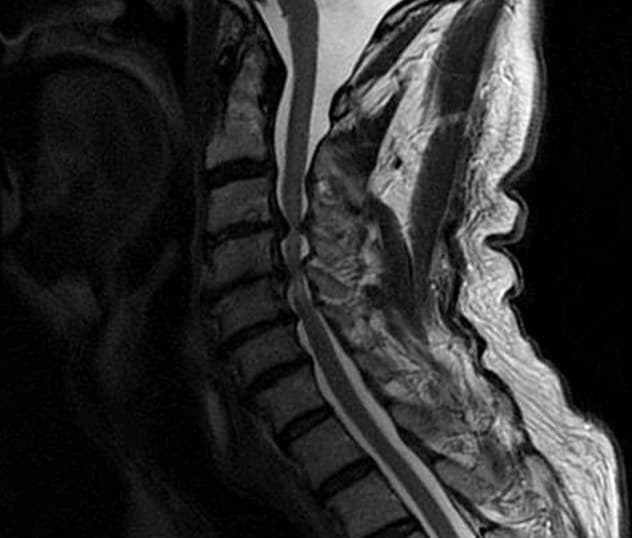Aug. 04, 2020
Cervical myelopathy is common and debilitating, yet consensus on optimal treatment is lacking. As many as 25% of patients require re-operation for symptom recurrence. Through groundbreaking research, Mayo Clinic is learning more about spinal cord mechanics to guide improved surgical treatment.
"We want to better understand how much stress is actually on the spinal cord so we can determine the best surgical approach for each patient," says Kingsley Abode-Iyamah, M.D., a neurosurgeon at Mayo Clinic in Jacksonville, Florida. "If surgery doesn't optimally position the spinal cord, the patient can have ongoing and worsening symptoms of myelopathy."
To that end, Mayo Clinic is using the first finite element model of the healthy and myelopathic C2-T1 cervical spine. The model, described in a study published in the February 2020 issue of Clinical Biomechanics, predicts how common surgical interventions affect spinal cord mechanics.
As expected, the study found that after surgery, patients had decreased spinal cord movement in the surgical area. "But interestingly, we also found that surgery didn't necessarily eliminate all the strain on the spinal cord," Dr. Abode-Iyamah says. "While the area that was decompressed showed decreased strain, other areas of the spinal cord started to see new stress."
Among all the surgical techniques studied, anterior cervical diskectomy and fusion (ACDF) increased adjacent-level strain and stress the most. The researchers suggest this might be due to a lack of spinal canal widening in the procedure compared with ACDF with laminectomy or double-door laminoplasty. Increased canal width allows for more spinal cord displacement, especially in extension, which may decrease the likelihood of spinal cord impingement elsewhere along the canal. The researchers also found that double-door laminoplasty allowed for more normal motion of the spine, as that procedure doesn't fuse the vertebral bodies.
"These results have the potential to change our approach in treating these patients," Dr. Abode-Iyamah says. "The goal is to return the patient's spine to the best alignment that will minimize stress and strain on the spinal cord."
Another area of interest is a genetic component to cervical myelopathies. Previous work by Dr. Abode-Iyamah and colleagues implicated a mutation known as Val66Met polymorphism in the pathophysiology of cervical spondylotic myelopathy (CSM).
Mayo Clinic is enrolling patients in a new study to determine how the polymorphism might affect the recovery process of people with CSM. "We hope to learn if there's an adjunct treatment we might give these patients before or after surgery to help their recovery," Dr. Abode-Iyamah says. "We would also like to find a way to screen patients and catch CSM early."
The importance of early intervention
Diagnosis of cervical myelopathy is often delayed. The most common early sign of the disease — loss of dexterity — can be attributed by patients and even physicians to normal aging.
"The disease process isn't generally associated with pain," Dr. Abode-Iyamah says. "Patients tell us, 'There's nothing wrong with my neck. But I can't button my shirt or put my earrings in.' Or 'My handwriting has gotten bad' or 'My balance isn't quite what it used to be and I am having more falls.' Those problems should trigger physicians to think about cervical myelopathy."
As the disease progresses, symptoms can include upper extremity numbness, neck pain and gait disturbance. Some individuals become wheelchair dependent. "Unfortunately, by the time some patients get to us, they are very debilitated," Dr. Abode-Iyamah says. "Cervical myelopathy really sneaks up on people. But the earlier you intervene, the better the outcome."
La resonancia magnética sagital de la columna cervical muestra una severa compresión de la médula con cambio de señal de la médula

La resonancia magnética sagital de la columna cervical muestra una severa compresión de la médula con cambio de señal de la médula
La resonancia magnética preoperatoria de un paciente con mielopatía cervical muestra la compresión de la médula espinal.
At Mayo Clinic, patients with suspected cervical myelopathy have MRI to check for spinal cord compression. If the MRI and clinical findings correlate and result in a diagnosis of cervical myelopathy, surgery is typically recommended.
"We don't know how fast the disease will progress once patients present with symptoms, and we want to halt that progression," Dr. Abode-Iyamah says.
"All of our work, in both research and clinical care, is focused on improving the functioning of the spinal cord," he adds. "We want to target our interventions so our patients get the best possible care."
For more information
Stoner KE, et al. A comprehensive finite element model of surgical treatment for cervical myelopathy. Clinical Biomechanics. 2020;74:79.